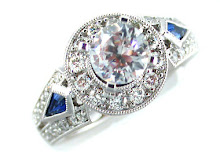 The "Roaring Twenties", so called "The Jazz Age", was a time of rapid change. U. S. women finally got the ri
The "Roaring Twenties", so called "The Jazz Age", was a time of rapid change. U. S. women finally got the ri ght to vote with passage of the 19th amendment. Prohibition, cocktail parties, wild dances, and new art forms must have seemed strange to many people used to life before the First World War. Eventually, fashion reflected the fact that women were more independent than ever before. Dresses were short and straight in new, thin fabrics with dropped waists. New lifestyles demanded for jew
ght to vote with passage of the 19th amendment. Prohibition, cocktail parties, wild dances, and new art forms must have seemed strange to many people used to life before the First World War. Eventually, fashion reflected the fact that women were more independent than ever before. Dresses were short and straight in new, thin fabrics with dropped waists. New lifestyles demanded for jew eled cigarette cases, cigarette holders, jeweled handbags and makeup cases. Old ideas of art and design continued through the Art Deco era but were combined with new stone cuts (emerald cuts, marquises, and pear shapes), platinum was used more and more often.
eled cigarette cases, cigarette holders, jeweled handbags and makeup cases. Old ideas of art and design continued through the Art Deco era but were combined with new stone cuts (emerald cuts, marquises, and pear shapes), platinum was used more and more often.Art Deco jewelry is often bold and angular - forming geometrical shapes. Women again wore multiples of rings, bracelets, necklaces, but in ways different from the past. In addition to precious stones, jewelry was made of paste, coral, crystal, and onyx.
An innovation of the Deco era was the Duette or Double-clip brooch: wide variety of looks could be created with one piece of jewelry that could be worn a s a single brooch or taken apart to wear as two pieces. The style for earrings was for long drops. These worked well to accent short hair and straight lines of dress.
s a single brooch or taken apart to wear as two pieces. The style for earrings was for long drops. These worked well to accent short hair and straight lines of dress.
Rudolph Valentino, the film star, helped create popular interest in wristwatches. Made in white gold, yellow gold, or platinum, they were often accented with pave' set diamonds, triangular cut sapphires, other cuts of gemstones or enamel. Pocket watches were on their way out.
Some features of Art Deco Era:
- Cubism and Geometric Designs
- Carnelian Onyx
- Diamonds, Rubies, Emeralds and Sapphires
- Amber Platinum
- Long-drops earrings
- Pins and brooches



No comments:
Post a Comment